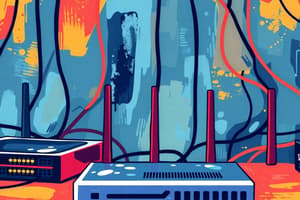Podcast
Questions and Answers
What does SOHO stand for in the context of networks?
What does SOHO stand for in the context of networks?
- Small Organization and Home Offices
- Simple Office and Home Online
- Small Office and Home Office (correct)
- Single Online Home Operations
Which is a characteristic feature of a Local Area Network (LAN)?
Which is a characteristic feature of a Local Area Network (LAN)?
- Owned by telecommunications providers
- Interconnects devices over large geographical areas
- Coverage spans multiple states
- Usually found in homes, schools, or small businesses (correct)
What is the primary difference between LANs and WANs?
What is the primary difference between LANs and WANs?
- There is no significant difference; they are used interchangeably.
- LANs use wireless connections only, whereas WANs do not.
- WANs provide access over wide geographical areas while LANs cover small areas. (correct)
- LANs are always corporate networks, and WANs are personal networks.
What role do peer-to-peer networks play in small office and home office setups?
What role do peer-to-peer networks play in small office and home office setups?
What is a key benefit of using networks for organizations?
What is a key benefit of using networks for organizations?
Which of the following best describes the internet?
Which of the following best describes the internet?
What is a common use for small office and home office networks (SOHO)?
What is a common use for small office and home office networks (SOHO)?
Which of the following statements is true regarding WANs?
Which of the following statements is true regarding WANs?
What is an extranet typically used for?
What is an extranet typically used for?
Which of the following is NOT a common use case for an extranet?
Which of the following is NOT a common use case for an extranet?
Which internet connection method is defined by its transmission alongside cable television signals?
Which internet connection method is defined by its transmission alongside cable television signals?
What type of DSL is commonly used by small office and home office users?
What type of DSL is commonly used by small office and home office users?
Which type of internet access does NOT require physical wiring to the premises?
Which type of internet access does NOT require physical wiring to the premises?
What is often a critical requirement for organizations looking to implement fast internet connections?
What is often a critical requirement for organizations looking to implement fast internet connections?
Which of the following is an example of a business-class internet service?
Which of the following is an example of a business-class internet service?
What type of internet connection typically runs over a telephone line?
What type of internet connection typically runs over a telephone line?
What is a primary limitation on performance for mobile internet connections?
What is a primary limitation on performance for mobile internet connections?
Which of the following describes Dial-up Telephone connections?
Which of the following describes Dial-up Telephone connections?
What type of internet connection is referred to as Ethernet WAN?
What type of internet connection is referred to as Ethernet WAN?
What is one of the chief characteristics of Dedicated Leased Lines?
What is one of the chief characteristics of Dedicated Leased Lines?
Which connection option provides high-speed uploads and downloads for businesses?
Which connection option provides high-speed uploads and downloads for businesses?
Why might satellite internet be a necessary option in certain areas?
Why might satellite internet be a necessary option in certain areas?
What was a common characteristic of networks in schools built thirty years ago?
What was a common characteristic of networks in schools built thirty years ago?
What might affect the choice of internet connection for businesses?
What might affect the choice of internet connection for businesses?
What does a converged network allow to be delivered over the same infrastructure?
What does a converged network allow to be delivered over the same infrastructure?
Which aspect of network reliability pertains to maintaining service during device failures?
Which aspect of network reliability pertains to maintaining service during device failures?
Which characteristic of network architecture allows for growth and adjustment to increasing demand?
Which characteristic of network architecture allows for growth and adjustment to increasing demand?
What principle allows messages to be rerouted in a fault tolerant network?
What principle allows messages to be rerouted in a fault tolerant network?
Which of the following best describes redundancy in networking?
Which of the following best describes redundancy in networking?
What is meant by Quality of Service (QoS) in networking?
What is meant by Quality of Service (QoS) in networking?
Why is network reliability considered crucial in today’s environment?
Why is network reliability considered crucial in today’s environment?
Which of the following is NOT one of the four basic characteristics that network architects must address?
Which of the following is NOT one of the four basic characteristics that network architects must address?
What does BYOD stand for in a networking context?
What does BYOD stand for in a networking context?
What is the primary purpose of collaboration tools like Cisco WebEx?
What is the primary purpose of collaboration tools like Cisco WebEx?
How does video conferencing enhance communication in organizations?
How does video conferencing enhance communication in organizations?
What role do data centers play in cloud computing?
What role do data centers play in cloud computing?
What is a significant benefit of cloud computing for businesses?
What is a significant benefit of cloud computing for businesses?
Which of the following is NOT a feature of Cisco Webex Teams?
Which of the following is NOT a feature of Cisco Webex Teams?
In what context is video becoming increasingly critical?
In what context is video becoming increasingly critical?
What is a key reason why organizations prioritize collaboration?
What is a key reason why organizations prioritize collaboration?
Flashcards are hidden until you start studying
Study Notes
What is SOHO?
- SOHO stands for Small Office/Home Office
- These networks enable people to work remotely
- Many self-employed workers use SOHO networks to operate businesses
- Large organizations use networks to centralize data storage and access
Types of Networks
- Peer-to-peer networks are commonly used in small businesses and homes where individual computers act as both servers and clients
- LAN (Local Area Network): connects devices in a small geographical area like a home, office, or school
- WAN (Wide Area Network): connects networks across a wide geographical area, typically owned and managed by large corporations or telecommunications providers
Extranets
- Provide secure access for individuals from different organizations who need access to data
- Examples: companies providing access to suppliers and contractors, hospitals providing appointment systems to doctors, schools providing budget and personnel information to districts
Internet Connections
- ISP (Internet Service Provider): provides internet access to home users, remote workers, and small offices
- Broadband Cable: high-bandwidth, always-on connection using the same cable as cable television
- DSL (Digital Subscriber Line): high-bandwidth, always-on connection over telephone lines with faster download speeds than upload speeds
- Cellular: internet access using a cell phone network with performance limited by the phone and cell tower capabilities
- Satellite: internet access via satellite dishes useful in areas without wired connectivity but requires a clear line of sight to the satellite
- Dial-up Telephone: low-bandwidth connection using a modem and phone line suitable for mobile access but not large data transfers
Business Internet Connections
- Businesses require higher bandwidth, dedicated bandwidth, and managed services
- Dedicated Leased Line: reserved circuits within a service provider’s network used for private voice or data networking between geographically separated offices
- Metro Ethernet: extends LAN access technology into the WAN, enabling business broadband connection
- Business DSL: various formats available, with SDSL (Symmetric Digital Subscriber Line) providing high-speed upload and download speeds for businesses
Converging Networks
- Traditional Separate Networks: separated data, telephone, and video networks using different technologies and standards
- Converged Networks: combine data, voice, and video communication on a single network infrastructure with shared rules and standards
Reliable Networks
- Network Architecture: refers to technologies supporting the infrastructure and protocols that govern data movement across the network
- Fault Tolerance: building networks to limit the number of affected devices during failures and enabling quick recovery
- Redundancy: having multiple paths between source and destination for data transmission to ensure communication even if one path fails
- Scalability: the ability of a network to grow and accommodate increased users, devices, and data traffic without significant performance degradation
- Quality of Service (QoS): prioritizing data traffic to ensure critical applications and services receive optimal performance
BYOD (Bring Your Own Device)
- Any device, with any ownership, used anywhere
Online Collaboration
- Collaboration tools: allow individuals to connect, interact, and achieve objectives through instant messaging, video conferencing, and file sharing
- Cisco WebEx: a widely used collaboration tool
Video Communications
- Video calls and conferencing enable communication across geographic and cultural boundaries
- Video conferencing is a powerful tool for collaboration and communication within organizations
Cloud Computing
- Data Centers: facilities housing computer systems and associated components
- Cloud computing enables:
- Storing personal files and backing up entire drives over the internet
- Accessing applications like word processing and photo editing remotely
- Extending IT capabilities for businesses without requiring investments in new infrastructure, training, or software
Studying That Suits You
Use AI to generate personalized quizzes and flashcards to suit your learning preferences.




